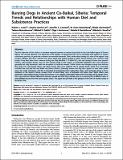Por favor, use este identificador para citar o enlazar a este item:
http://hdl.handle.net/10261/76932COMPARTIR / EXPORTAR:
 SHARE SHARE
 CORE
BASE CORE
BASE
|
|
| Visualizar otros formatos: MARC | Dublin Core | RDF | ORE | MODS | METS | DIDL | DATACITE | |

| Título: | Burying Dogs in Ancient Cis-Baikal, Siberia: Temporal Trends and Relationships with Human Diet and Subsistence Practices |
Autor: | Losey, Robert J.; Garvie-Lok, S.; Leonard, Jennifer A. CSIC ORCID; Katzenberg, M. Anne; Germonpré, M.; Nomokonova, Tatiana; Dablin, Mikhail; Goriounova, Olga I.; Berdnikova, Natalia E. | Fecha de publicación: | 2013 | Editor: | Public Library of Science | Citación: | PLoS ONE, 8(5):e63740 (2013) | Resumen: | The first objective of this study is to examine temporal patterns in ancient dog burials in the Lake Baikal region of Eastern Siberia. The second objective is to determine if the practice of dog burial here can be correlated with patterns in human subsistence practices, in particular a reliance on terrestrial mammals. Direct radiocarbon dating of a suite of the region’s dog remains indicates that these animals were given burial only during periods in which human burials were common. Dog burials of any kind were most common during the Early Neolithic (,7–8000 B.P.), and rare during all other time periods. Further, only foraging groups seem to have buried canids in this region, as pastoralist habitation sites and cemeteries generally lack dog interments, with the exception of sacrificed animals. Stable carbon and nitrogen isotope data indicate that dogs were only buried where and when human diets were relatively rich in aquatic foods, which here most likely included river and lake fish and Baikal seal (Phoca sibirica). Generally, human and dog diets appear to have been similar across the study subregions, and this is important for interpreting their radiocarbon dates, and comparing them to those obtained on the region’s human remains, both of which likely carry a freshwater old carbon bias. Slight offsets were observed in the isotope values of dogs and humans in our samples, particularly where both have diets rich in aquatic fauna. This may result from dietary differences between people and their dogs, perhaps due to consuming fish of different sizes, or even different tissues from the same aquatic fauna. This paper also provides a first glimpse of the DNA of ancient canids in Northeast Asia. | Versión del editor: | http://dx.doi.org/10.1371/journal.pone.0063740 | URI: | http://hdl.handle.net/10261/76932 | DOI: | 10.1371/journal.pone.0063740 |
| Aparece en las colecciones: | (EBD) Artículos |
Ficheros en este ítem:
| Fichero | Descripción | Tamaño | Formato | |
|---|---|---|---|---|
| fetchObject (1).pdf | 8,57 MB | Adobe PDF |  Visualizar/Abrir |
CORE Recommender
PubMed Central
Citations
10
checked on 31-mar-2024
SCOPUSTM
Citations
56
checked on 24-abr-2024
WEB OF SCIENCETM
Citations
44
checked on 24-feb-2024
Page view(s)
341
checked on 27-abr-2024
Download(s)
265
checked on 27-abr-2024
Google ScholarTM
Check
Altmetric
Altmetric
Artículos relacionados:
NOTA: Los ítems de Digital.CSIC están protegidos por copyright, con todos los derechos reservados, a menos que se indique lo contrario.
